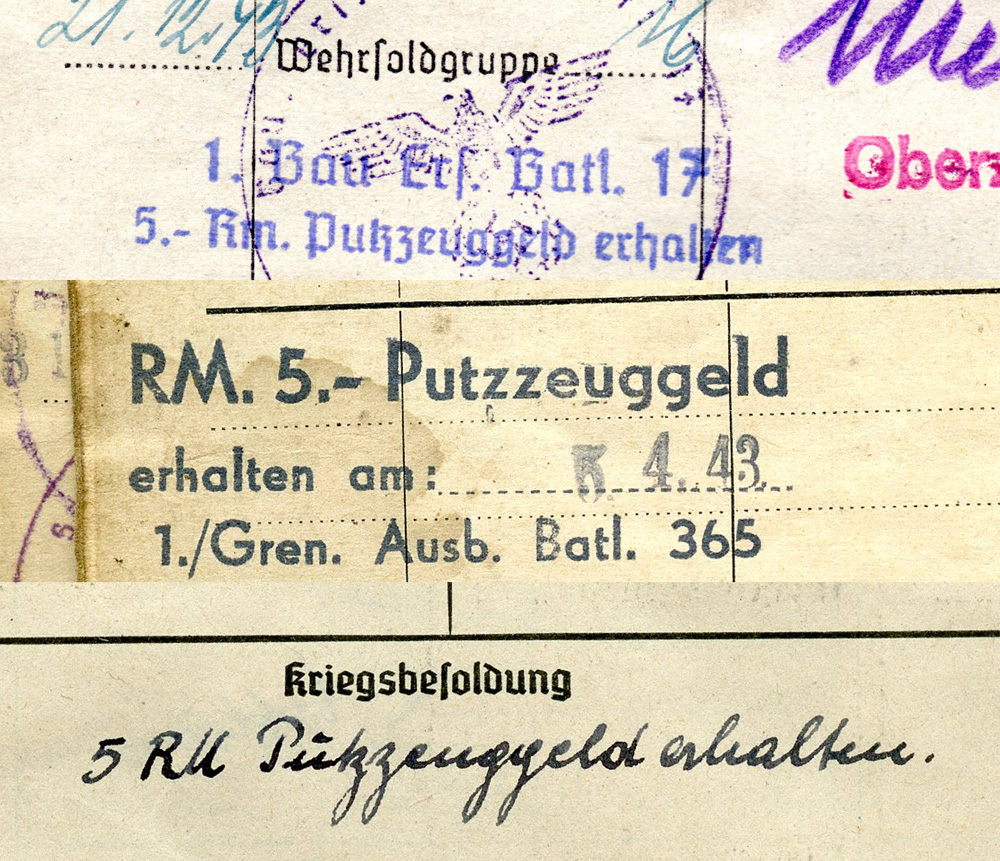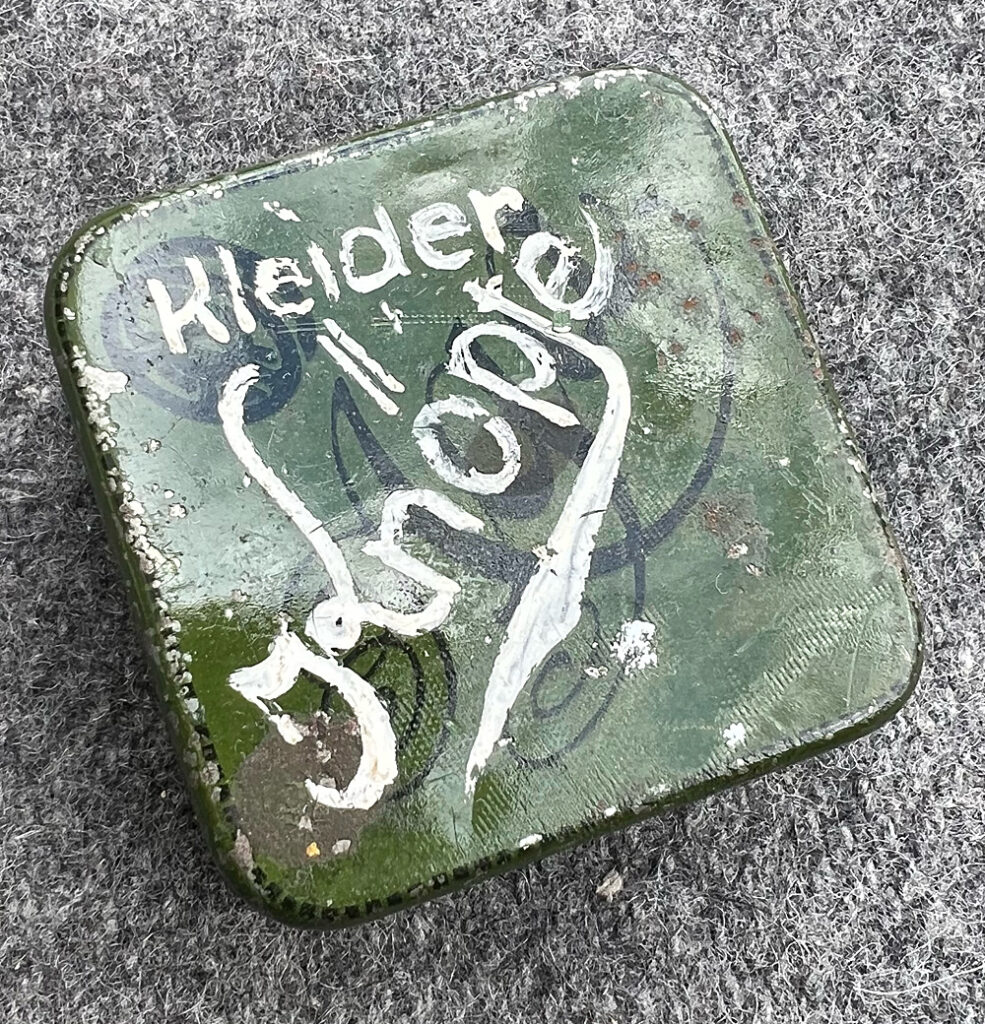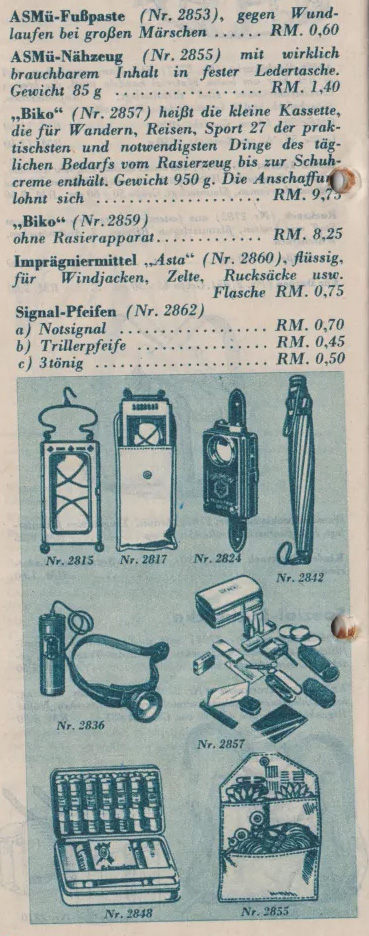Generally speaking, sewing kits were not issued to personnel of the German military in WWII. The Wehrmacht manual “Hilfsbuch für den Hauptfeldwebel” indicated that enlisted men were to have sewing supplies in the form of a pair of scissors, sewing and darning needles, darning yarn, black, white and gray thread, and various buttons, but that they had to obtain these items by their own means, from what was commercially available. The items they could have bought would be the same items available to civilians at the time.
In addition to sewing supplies, soldiers had to obtain other materials for maintaining their equipment, including leather polish and brushes. Enlisted recruits received a bonus payment of 5 Reichsmarks in order to buy these needed supplies. This bonus was called “Putzzeuggeld,” literally “cleaning kit money.” Five Reichsmarks was the equivalent of about 43 US dollars in 2023. Here are a few wartime Soldbuch entries showing this Putzzeuggeld payment.

These “Kameradenhilfe” sewing kits are typically associated with Wehrmacht use, though I have not been able to find documentation about these. Here are three of the pouches, two with contents.

Sewing kits like these were handy items that would have been seen as practical and usable items after the war as well. The contents of these could have been changed or added after the war. Both of these currently have very similar contents including cloth-covered underwear buttons, linen thread, and needles in paper packets with wording indicating military use.

Another sewing kit style associated with wartime use is this metal tin. The lettering style and “D.R.G.M.” marking are consistent with Third Reich era commercial production.

The inside of this tin has four divided compartments. This one has no contents.

This sewing kit is in a simple paper envelope.

The back of this paper kit is decorated with a winter scene depicting soldiers in a trench.

The inside of this kit has needles, safety pins, and an assortment of military type buttons.

This simple sewing kit was made by filling a repurposed typewriter ribbon tin. The top of the tin has been painted with an artistically rendered “Kleider Knöpfe,” for clothing buttons. The tin holds buttons, sewing thread, darning yarn, and a packet of needles. This kit has no story or provenance but it is easy to imagine German soldiers using items like this, that could be tucked in a bread bag until needed.


Cleaning kits were marketed to recruits, by companies hoping for some of that 5 Reichsmark “Putzzeuggeld” bonus. The tin container at top is one such example. There were several varieties of these cleaning kits, and presumably these would have had the required sewing supplies in addition to brushes and leather care items. The aluminum “Mica” box at bottom was a personal items kit that contained hygiene items like shaving gear and a toothbrush as well as brushes and shoe cream. These kits were marketed under the brand names “Mica” and “Bico” and were marketed to soldiers and civilians.

This section of the 1937 ASMü (August Schuster, München) catalog shows the Bico kit and its contents, including a small scissors and what appears to be a small tin with sewing supplies. This kit is priced at RM 9.75 complete with a razor. A sewing kit is also shown, housed in a sturdy leather pouch, priced at RM 1.40.

Did German soldiers in the field carry sewing kits? No doubt, in an army of millions of men, some must have. I had a chance to ask a veteran of Fallschirm-Panzer-Regiment “Hermann Goering” about this. I showed him a reproduction of the “Kameradenhilfe” sewing kit and asked him if he had seen any like it. He chuckled and shook his head. “Maybe soldiers in Denmark had something like that,” he said, meaning garrison troops. “We never had that.” He said that in the field, in the combat zone, if your button fell off, you just went without a button. That was one man’s experience.
The existence of the sewing needle packets with wording that indicates military use, suggests that despite regulations that soldiers had to supply their own sewing supplies, some may have been issued. Everything a German soldier was issued was listed in his Soldbuch. This is the only Soldbuch entry I have ever seen for anything sewing related, in this case a “Nähbeutel,” a sewing pouch. Was this the Kameradenhilfe kit, or something like it? Or the civilian-looking paper envelope pictured above, which has the word “Nähbeutel” on the front and includes military type buttons? Perhaps future discoveries will shed more light on this topic.
